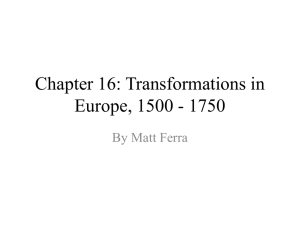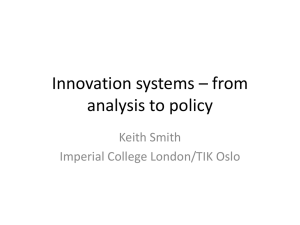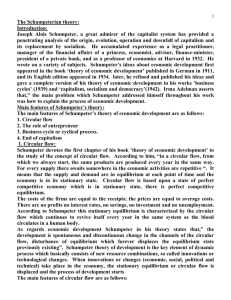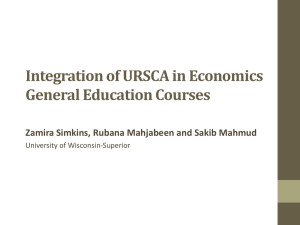Lundvall1
advertisement
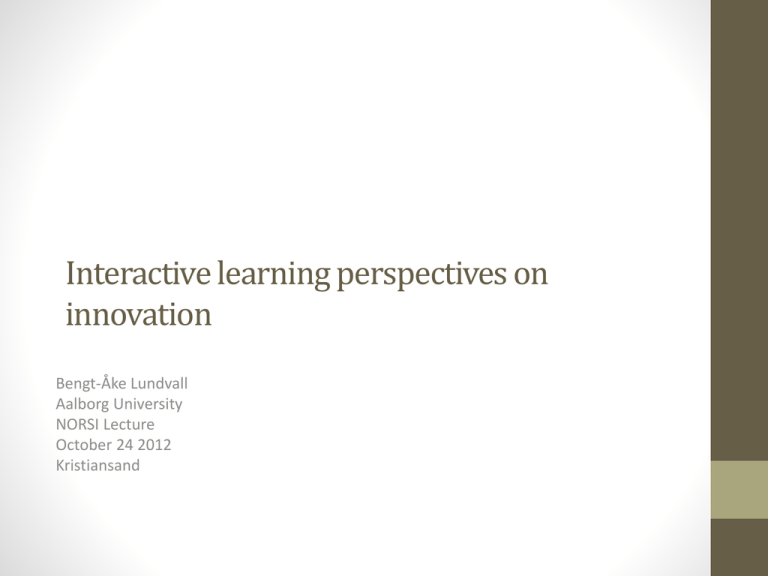
Interactive learning perspectives on innovation Bengt-Åke Lundvall Aalborg University NORSI Lecture October 24 2012 Kristiansand My background • Professor in Economics, Aalborg University, Denmark. • Have worked on innovation and industrial development since the end of the 1970s. • Developed, together with Chris Freeman, the concept ’National System of Innovation’ in the first half of the 1980s. • Initiated Globelics network 2000 with more focus on developing countries (see www.globelics.org). • March 2012 my Anniversary Symposium in Aalborg gave my reason to reflect on what I have learnt. Theme for Today is a follow up to this symposium where I argued that: • ‘Innovation as an interactive process’ constitutes a theoretical core of innovation studies. Summing up the lecture 1. Innovation as an interactive process is at the theoretical core of innovation studies! • • • • 2. Limits of standard economics • • 3. Origin: The theoretical divide between science-push and demand pull: Schumpeter versus Schmookler: On the important role of ‘paradigmatic cases’ in innovation studies. The role of respectively the Sappho-study and the Mike-project. Dimensions of interaction within and across organisational borders. Innovation as an interactive process as reflected in the most cited works in innovation studies. the assumption of pure market. the reduction of work to employment. Toward a more general theory of innovation as an interactive process and implications for future research. Innovation studies: Challenging the boundaries • The entrepreneurship studies core according to Shane (2000) : the key building blocks are respectively the individual and the opportunities that he/she faces. The process of entrepreneurship is one where individuals perceive, assess and act in relation to opportunities. • The innovation studies core (bal): innovation as an interactive process. The innovation process is one where individuals or organisations interact engaging in information exchange, problem solving and mutual learning . In this process they establish ‘relationships’ that may be seen as constituting ‘innovation systems’. Schumpeter’s supply side bias • Schumpeter had focus on supply side • First defining the individual entrepreneur as the most important driver of innovation – In Theory of Economic Development – often referred to as Schumpeter Mark I. • Second defining the big oligopolist coporations and their R&D-department as the most important driver of innovation – often referred to as Schumpeter Mark II. • Schumpeter assumed that users and consumers would accept and use new processes and products. But he did not give them any active role. Heneglected the demand side. Schmookler’s challenge – on the importance of the demand side • Jacob Schmookler explored statistically the economics of technological innovation at a detailed industry level. He crystallized the notion of endogenous technological change and its influence on economic growth two decades before the concept was reinvented by macro economists. • Through analysis of time series and cross-sectional patent data and historical case studies, Schmookler demonstrated that demand-pull influences were also important: the more intense the demand, the more creative groups and individuals were drawn to work on an unsolved problem and the more patentable inventions they generated (Schmookler 1966 and 1972) Christopher Freeman: The father of modern innovation theory • Economist from Cambridge – went to Keynes’ lectures, read Marx and Schumpeter. • Among Freeman’s favourite themes beginning of the 80’s were: • The need to overcome the split between innovation as driven by supply factors versus innovation as driven by demand factors. • The importance of understanding interaction between agents in the innovation process. • Collaboration with Freeman in the beginning of the 1980s inspired the Mike project – see below. In innovation studies theories reflect experiences from ‘paradigmatic cases’ – • • • • Schumpeter on Railways Freeman on Chemical industry and the Sappho-study Rosenberg on textiles and textile machinery Dosi on semiconductor industry • Major historical and empirical projects are important sources for theory building in innovation studies. • Theory is grounded. Innovation phenomenon is seen as context specific and therefore the outcome is history friendly modelling rather than general theory. Sappho-project 1972 was important in opening up for the insight that innovation is an interactive process (cf. Chesbrough on Open Innovation) The Sappho-project was organised at Science Policy Research Unit at Sussex university by Freeman, Rothwell and others. On the basis of pair-wise analysis of successful and unsuccessful innovations it was shown that firms that introduced successful in innovation: 1. Interact more closely with customers, suppliers and knowledge institutions (interorganisational interaction). 2. Are characterised by closer interaction across departments within the firm (intraorganisational interaction). The Mike project 1980-83 another crucial experience and paradigmatic case A project on the socio-economic impact of microelectronics. Our Method: Studying the development, diffusion and use of technology in ‘industrial complexes’. • Confirmed the importance of interactive learning involving users and producers. • But we also found that the ‘quality’ of the relationship was as important as the strength. • Strong and close relationships may hamper innovation or give rise to ‘unsatisfactory innovation’. The problem of lock in and weak user competence. • Industrial complex as more than a cluster – cf. Military industrial complex or for Financial Industrial complex with political power. Product innovation and User-producer interaction - follow up to Mike-project • Product innovation - the informational paradox – on the information needs of Producers and Users Product innovation neither in neoclassical pure markets nor in transaction economics markets (Williamson 1975) The organised market as solution • • • • Learning to communicate ( investing in codes and channels) Building trust and patterns of dominance The product innovation paradox – confrontation with transaction economics Market where product innovations appear would be characterized by extreme uncertainty (uncertainty regarding the commodity itself). This would according to transaction cost theory (Oliver Williamson) imply high transaction costs and result in vertical integration. Again we would expect little product innovation. This is in contrast with reality - more than 50% of innovations are product innovations (addressed to external users). Why prefer the organised market to the hierarchy? • The producer who integrates with one specific user excludes himself from access to information and interactive learning with the other users – lock in. • The user who integrates with one specific producer excludes himself from access to information and interactive learning with the other producers –lock in. • Opportunism is not the general rule – it may flourish in some contexts but not in others. • To analyse vertical integration you have to include benefits from interactive learning on line with transaction costs. Is learning a transaction? What is going on in the interaction between users and producers? • Analysis primarily referring to professional users – in consumer markets producers dominate the interaction and needs are fuzzy for the observer. • Producers monitoring the users in terms of their processes and products • Producers involved in the implementation of new products with feed back – learning from it • Users monitoring the new technological opportunities among producers • Users draw upon producers when installing the new product – learning from problem solving Unsatisfactory innovations • Unsatisfactory innovations are innovations that do not respond to the needs of the users and that do not exploit technological opportunities. They are typically reflecting trajectories that are taken too far. • Unsatisfactory innovations appears when user or producers dominate and when innovations are systemic. • Unsatisfactory innovations may reflect missing or obsolete relationships in the context of technological revolutions. Locational issues • The role of Distance • Geographical • Cultural • Depends on: • Technology life cycles • Paradigmatic shift • Mature technologies • Distinction between the kind of knowledge exchanged in the interaction – tacit versus explicit Units of analysis • From industries to verticals of production and industrial clusters (cf. Porter) • International competition between verticals of production and between national production systems • Industrial complexes (clusters) as elements of strength and weakness in national systems of production. • Clusters are not harmonious families of firms – there power struggles within and shared power in relation to society. Innovation Process within the firm Innovation needs to draw upon new knowledge (from R&D-department) Innovation needs to match the needs of production (involves the production department). Innovation needs to match the characteristics of new products (involves the marketing department) Horizontal interaction across the borders of departments is crucial for the success of innovation. This is why learning organisations are more innovative. In house interaction and Learning organisations • Are more flat and allow horizontal communication inside and outside the organisational borders • Establish cross-departmental and crossfunctional teams and promote job-circulation between functions. • Delegate responsibility to workers and invest in their skills • Establish closer co-operation with suppliers, customers and knowledge institutions. Conclusions of the first part • The attack on standard economics and transaction cost theory for their neglect of product innovation. Positive sum game. • UP-perspective could be applied to intra-firm relationship! • But also critical lessons for cluster analysis from the industrial complex perspective – • Lock in, imbalanced power and capability and unsatisfactory innovation • Cluster as collective political factor The core literature 1990-2009 – all the five most cited works in Handbooks on innovation – are about innovation as interactive proces and about innovation systems. Nelson, R. (1993): National Innovation Systems: A Comparative Study Porter, M. (1990):The Competitive Advantage of Nations Lundvall, B.-Å. (1992): National Systems of Innovation Cohen, W. and D. Levinthal (1990):Absorptive capacity: A new perspective on learning and innovation Saxenian, A. (1994): Regional Advantage The Modern understanding of the Innovation Process • Most innovations are outcomes of combinations of diverse elements of knowledge. • Such outcomes reflect interaction among agents with different insights and skills. • Interaction is social and reflects formal and informal institutions. • The economy is organised and constituted by social relationships – not just a set of pure markets! Evolutionary socio-economics vs Standard economics – a double change of focus Allocation of given use values Rational choice Standard by economics homogenous agents Learning among diverse agents Innovation: Creation of new use values Evolutionary economics Adam Smith on Innovation and Specialisation in Science • Many improvements have been made by …. those who are called philosophers or men of speculation … who …are often capable of combining together the powers of the most distant and dissimilar objects. • In the progress of society, philosophy or speculation becomes, like every other employment…. subdivided into a great number of different branches, each of which affords occupation to a peculiar tribe or class of philosophers; (Adam Smith 1776: p. 9) : Toward a general Theory of Innovation ’Dynamizing Adam Smith’ • Innovation are new combinations: they combine diverse (distant!) elements of knowledge and innovation thrives when people with different background meet and interact. • Innovation drives and shapes the division of labour. The evolution of the division of labour contributes to diversity and opens up new interfaces for interaction. But Smith forgot to tell that the formation of ’tribes’ establish communication problems. (Compare for the barriers between innovation studies, entrepreneurship studies and STS-studies) • Short social distance and low cultural barriers facilitate interactive learning and promote innovation. Tolerant environments are good for innovation (cf. Florida). Innovations as outcomes of interaction between ’disparate actors’ • Innovations are new combinations of existing knowledge elements and these new combinations originate from interaction among individuals and organisations with different kinds of knowledge. • Growing specialisation increases the degree of knowledge diversity and it increates the potential for new combinations. • But there are barriers between: • Disciplines • Professions • Functional departments • Nation states Some implications for future research • One of my conclusions from studying this field is that there is no meaningful ’pure’ economics of innovation! • This follows from the fact that the learning processes that are at the very core of innovation are interactive and therefore will be affected by the existing social relationships. • This implies that a neglect of the social dimension in innovation studies will give misleading insights also in what works at the national and enterprise level. • We need much more systematic empirical research and theoretical work on interaction and relationships: • Knowledge taxonomies • Technology taxonomies • Indicators • THANK YOU FOR YOUR ATTENTION

